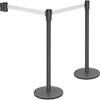Filter by
Color
Safety Barrier Component
Window Style
DFARS Specialty Metals
Export Control Classification Number (ECCN)
Fencing Component
Message
Maximum Expanded Width
Most Likely Products
All Results
Safety Equipment
Building and Machinery Hardware
Facility and Grounds Maintenance
Heating, Ventilation, and Air Conditioning
Communication


























































